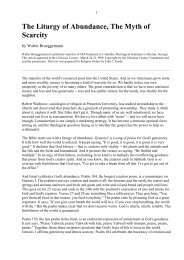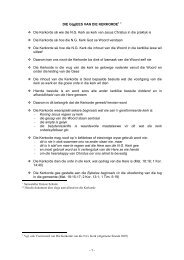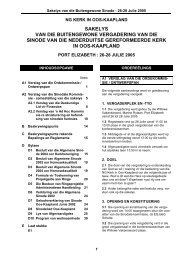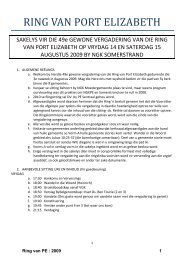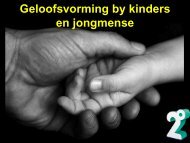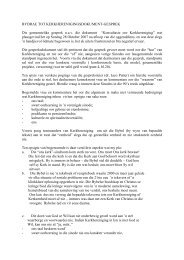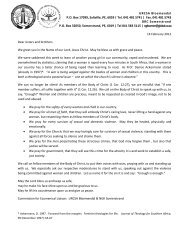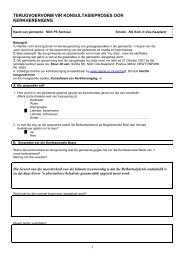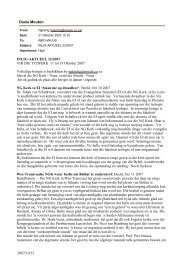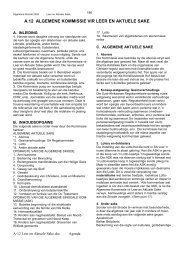You also want an ePaper? Increase the reach of your titles
YUMPU automatically turns print PDFs into web optimized ePapers that Google loves.
4.5<br />
In 1992 the WCC Central Committee accepted a set of "Guid<strong>in</strong>g Pr<strong>in</strong>ciples for Relationships and<br />
Cooperation between Regional Ecumenical Organizations and the World Council of Churches". They def<strong>in</strong>e<br />
the relationship as one of "partnership based on their common faith and commitment", characterized by<br />
complementarity, mutual trust and reciprocity. While much progress has been achieved <strong>in</strong> <strong>in</strong>formationshar<strong>in</strong>g,<br />
mutual consultation and programmatic collaboration, the magnitude of the common tasks and<br />
challenges to be faced with severely limited resources suggests the need to establish more <strong>in</strong>tentional<br />
structural l<strong>in</strong>ks to enable common plann<strong>in</strong>g and decision-mak<strong>in</strong>g as well as an effective division of labour.<br />
Both the WCC and the REOs recognize the NCCs as essential partners <strong>in</strong> their work, mediat<strong>in</strong>g and<br />
coord<strong>in</strong>at<strong>in</strong>g relationships with the member churches <strong>in</strong> a given country; and this should be recognized <strong>in</strong><br />
any effort to develop a comprehensive framework l<strong>in</strong>k<strong>in</strong>g the different councils and conferences of churches<br />
<strong>in</strong> the one ecumenical movement.<br />
4.6<br />
The ecumenical movement is both universal and local. The oneness of the ecumenical movement<br />
worldwide should be evident <strong>in</strong> each local, national or regional council of churches, just as the WCC must<br />
rema<strong>in</strong> firmly <strong>in</strong> touch with the reality of local communities where Christians are gathered to worship and<br />
serve.<br />
Other ecumenical bodies<br />
4.7<br />
In addition to its relations with councils of churches of differ<strong>in</strong>g geographical scope, the WCC is <strong>in</strong><br />
relationship with a variety of other ecumenical bodies.<br />
4.8<br />
An important relationship is that between the WCC and the diverse bodies known generally as Christian<br />
World Communions. Aga<strong>in</strong>, these relationships should be marked by mutual accountability and reciprocity,<br />
and the Council should seek ways to share tasks and resources with these partners <strong>in</strong> the ecumenical<br />
movement. Such shar<strong>in</strong>g is particularly important for those bodies which understand themselves as one<br />
worldwide communion of churches and of which most if not all members are also member churches of the<br />
WCC. Ways should be found to associate such bodies more directly with the organized life of the WCC. A<br />
strong relationship between the WCC and these bodies can be enrich<strong>in</strong>g for both, strengthen<strong>in</strong>g the sense<br />
of the latter that they are part of the worldwide fellowship of Christians and rem<strong>in</strong>d<strong>in</strong>g the churches <strong>in</strong> the<br />
World Council that ecumenical commitment can be nourished by rootedness <strong>in</strong> an ecclesial tradition.<br />
4.9<br />
The WCC is constituted as a council of churches. This is a central statement of its identity. However, the<br />
constitutional documents of the WCC recognize that the Council must ma<strong>in</strong>ta<strong>in</strong> work<strong>in</strong>g relationships with a<br />
wide variety of <strong>in</strong>ternational ecumenical organizations, some of which are older than the WCC itself. These<br />
<strong>in</strong>clude organizations represent<strong>in</strong>g particular constituencies - such as youth, students, women, lay people -<br />
and bodies and agencies with a particular functional purpose or m<strong>in</strong>istry <strong>in</strong> such fields as education,<br />
communication, resource shar<strong>in</strong>g and development. As organizations with an <strong>in</strong>ternational scope and<br />
mandate, most of them understand themselves as carry<strong>in</strong>g out a specialized m<strong>in</strong>istry <strong>in</strong> response to the<br />
same ecumenical call<strong>in</strong>g as the member churches of the WCC. Strengthen<strong>in</strong>g the partnership with these<br />
organizations will be of vital importance for the WCC <strong>in</strong> the effort to ma<strong>in</strong>ta<strong>in</strong> the coherence of the<br />
ecumenical movement.<br />
4.10<br />
The dynamic of the ecumenical movement over the past decade has given rise to various Christian<br />
communities and movements. Most have a flexible organizational structure as part of the wider network of<br />
social or popular movements, but they have become important partners of the WCC <strong>in</strong> service, especially <strong>in</strong><br />
work<strong>in</strong>g for justice, peace and the <strong>in</strong>tegrity of creation. Many of these movements have been prophetic<br />
with<strong>in</strong> and beyond the churches and have opened up new ways of Christian witness <strong>in</strong> the wider<br />
community. The WCC should cont<strong>in</strong>ue to offer itself as a forum where such communities or movements<br />
whose objectives and activities are <strong>in</strong> harmony with the Basis, purpose and functions of the WCC can meet<br />
and cooperate.<br />
Churches which are not members of the WCC<br />
4.11<br />
The Roman Catholic Church has been, s<strong>in</strong>ce the Second Vatican Council, an active participant <strong>in</strong> the<br />
ecumenical movement and a valued partner <strong>in</strong> numerous ways with the WCC (especially through the Jo<strong>in</strong>t<br />
Work<strong>in</strong>g Group and participation <strong>in</strong> the Commission on Faith and Order). The member churches of the<br />
WCC and the Roman Catholic Church are <strong>in</strong>spired by the same vision of God's plan to unite all th<strong>in</strong>gs <strong>in</strong><br />
Christ. It is <strong>in</strong>conceivable that either the WCC or the Roman Catholic Church could pursue its ecumenical<br />
call<strong>in</strong>g without the collaboration of the other; and it is to be hoped that both will f<strong>in</strong>d ways to deepen and<br />
expand this relationship, particularly s<strong>in</strong>ce the Roman Catholic Church has <strong>in</strong> recent years become part of a<br />
grow<strong>in</strong>g number of local, national and regional ecumenical bodies of which WCC member churches are<br />
also part. While membership <strong>in</strong> the WCC is by no means the only way for the churches to work together on<br />
a worldwide level, some member churches of the WCC which ma<strong>in</strong>ta<strong>in</strong> bilateral relations with the Roman<br />
Catholic Church believe that the fellowship of the WCC is impoverished by the absence of the Roman<br />
Catholic Church from this circle of churches.<br />
4.12<br />
The fellowship of the WCC is limited by the absence of other churches which, for various reasons, have<br />
not sought membership. For example, unjustifiable barriers have arisen between the WCC and some<br />
Evangelical and Pentecostal churches because of tendencies on both sides to caricature or rema<strong>in</strong><br />
<strong>in</strong>different to each other. Some of these barriers have begun to break down through the development of<br />
ongo<strong>in</strong>g contacts between the WCC and other bodies, such as the World Evangelical Fellowship. These<br />
ÏÌ



